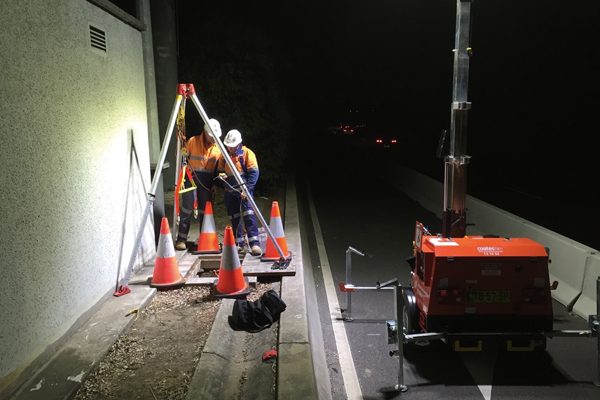Connecting the west
As Sydney continues to expand, FODC general manager Michael McKeogh talks about working on one of the city’s big fibre optic installations. Esther Rivers reports.
Over the past 14 years Fibre Optics Design and Construct (FODC) has been at the helm of some of Sydney’s largest fibre optic infrastructure projects.
The projects range from the Sydney Harbour Bridge to cabling the Lane Cove and Harbour tunnels.
ADVERTISEMENT
The company has also been responsible for communications projects on major motorways throughout the city. In 2018 it won the NECA National Excellence Award (Industrial – Small) for its work on the M5 Motorway.
According to WestConnex, the M5 Motorway will have 9km twin motorway tunnels from Kingsgrove to a new St Peters interchange. It will have underground connections to the M4- M5 link and will connect to the future Sydney Gateway.
“The WestConnex consortium called us directly,” Michael says.
“They hadn’t known what to do or how to do it, so they approached Roads and Maritime Services and we were recommended. That’s how we got involved. It was a competitive tender.”
The project was quite detailed, and it had plenty of challenges.
“Once a month there are various shut downs on the M5 tunnel, when they stop traffic altogether. They shut down in the evening for about five hours on a couple of days, so we had that window to work in.
“It’s an incredibly tight timeframe to work in when you’re relocating all the equipment on that motorway.
“On the nights when they already had a shutdown period for other maintenance we would jump in and do some of the work. Then it had to be up and running again at four in the morning.”
Michael says not everything goes to plan on a project of this nature. To house crucial radio re-broadcast equipment FODC had a stainless steel cabinet custom built.
“The radio rebroadcast system had been down on the motorway, and we learnt that there had been trouble with the signal quality from time to time.
“We suggested housing the equipment on top of the hill in a building they owned that had a ventilation stack.
“We got the cabinet built in Unanderra, just south of Wollongong. It was made from the highest grade stainless steel – a grade above 316.”
The ventilation stack turned out to be a highly corrosive environment.
“Repositioning the re-broadcast system allowed the broadcast signal to reach a wider area, but it required a lot of work.
“We had to connect new fibre optic circuits and get new modems so that they could transmit the signal from the motorway all the way to the top of this hill.
“We had to get specialist equipment so they could send that signal and drive fibre optics up to this specially built cabinet. Then we had to run coaxial cables and put antennas on top of the building.
“We mounted this stainless steel cabinet down in the bowels of the building, but the antenna obviously had to be way above the building. So we were running cables through quite a harsh industrial environment up to the top of this ventilation stack so that we could re-broadcast the signal.”
FODC audited the services then documented the information in order to develop design drawings for the relocation.
“That was a huge project. It probably took six months. No one else could work out how we were going to do the job. It required us to come up with a lot of documentation and drawings just to give them the confidence that we could actually achieve it.”
This was one of several obstacles thrown up by the project – convincing the client that FODC had what it took to complete such a job.
“To relocate all of these fibre optic cables, the power cables, all of the equipment … it was a whole control room that had to be shifted. A lot of it was based on trust that we’d built up over the years. They said ‘we don’t know how you’re going to do this but just go for it’.”
The project team involved 10 people overall, including specialists. The FODC team of six people worked for 12 months to fully complete the project. However, some jobs were not foreseen.
“We discovered that a lot of the cables were in confined spaces, so we had to get ticketed for working in confined spaces. That was unexpected.
“A couple of times the power feeds came from an unexpected direction when we went to do the isolation, and some of the information we’d been given was a bit wrong.
“The overall time for the project was 12 months but it wasn’t full time, it was only worked on during those night shift periods.
“The other degree of difficulty is when you have allowed for an eight-hour shift but on night shift you can achieve only four or five hours of productive work.”
However, the job was completed much to the satisfaction of everyone involved.
“With only a short window we had to come up with a design, and there were no engineers on it. This is what made the project remarkable.”
-
ADVERTISEMENT
-
ADVERTISEMENT


